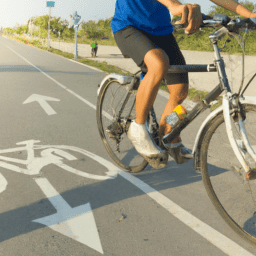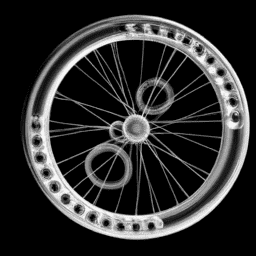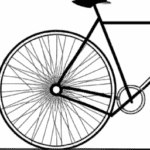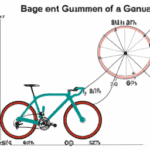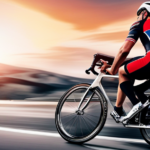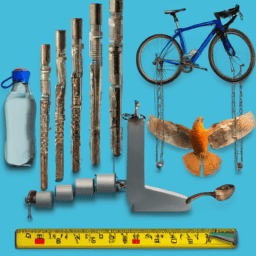As someone who enjoys cycling, I’m always fascinated by the scientific principles behind biking. A fact that always stands out to me is that an average bike rider can produce roughly 200 watts of energy when cycling at a steady pace of 15 miles per hour.
But beyond just power output, there are many other factors at play when it comes to riding a bicycle, including the direction of angular velocity. Angular velocity is a measurement of how quickly an object is rotating around a central axis. In the case of a bicycle, the wheels are rotating around their axles, creating angular velocity.
But in what direction does this velocity occur when riding a bicycle? This is a question that many cyclists may not have considered, but understanding the direction of angular velocity can help to explain some of the nuances of riding a bicycle, from maintaining balance to turning corners.
In this article, we will explore the direction of angular velocity when riding a bicycle, and how it changes depending on various factors.
Key Takeaways
- Angular velocity is a measure of rotational speed and is in the same direction as wheel rotation.
- Understanding the direction of angular velocity is important for riding a bicycle, especially when making turns and riding in a straight line.
- Changes in angular velocity are caused by centripetal force and factors such as mass, shape, size of wheels, terrain, and gear ratio can affect it.
- Uphill direction is negative and downhill direction is positive in relation to changes in angular velocity direction when riding a bicycle.
Understanding Angular Velocity
You’re probably wondering, "Which way am I spinning?"Well, the answer lies in understanding angular velocity.
Angular velocity refers to the rate of change of angular displacement with respect to time. In simpler terms, it’s the speed at which you’re rotating around a fixed axis. When you ride a bicycle, your angular velocity is in the same direction as the rotation of the wheels. This means that if the wheels are rotating clockwise, then your angular velocity is also in the clockwise direction.
It’s important to note that there’s a relationship between angular velocity and linear velocity. Angular velocity determines the rate at which you’re turning, while linear velocity determines the rate at which you’re moving forward.
Additionally, the angular acceleration of the wheels also affects your angular velocity. A higher angular acceleration will result in a faster rotation and thus a higher angular velocity.
Now that we understand the basics of angular velocity, let’s explore the direction of wheel rotation.
Direction of Wheel Rotation
Interestingly enough, the wheels on your trusty two-wheeled mode of transportation happen to spin in a specific way. When you ride a bicycle, the direction of wheel rotation is dependent on the orientation of the bicycle. If you are riding in a forward direction, the wheels will rotate clockwise when viewed from the right side of the bike and counterclockwise when viewed from the left side of the bike. This is due to the orientation of the axle and the direction of the centripetal force acting on the wheels.
To better understand the direction of wheel rotation, let’s take a look at the following table:
| Orientation of Bicycle | View from Right Side of Bike | View from Left Side of Bike |
|---|---|---|
| Forward | Clockwise | Counterclockwise |
| Backward | Counterclockwise | Clockwise |
| Left Turn | Downward | Downward |
| Right Turn | Upward | Upward |
| Stop | No rotation | No rotation |
As you can see, the direction of wheel rotation changes depending on the orientation of the bicycle. This is important to understand when it comes to maneuvering the bike, especially when making turns. In the next section, we will discuss how to ride a bicycle in a straight line.
Riding a Bicycle in a Straight Line
In this subtopic, I’ll be discussing the concept of riding a bicycle in a straight line. This involves understanding the direction of angular velocity and the various factors that affect it.
As a cyclist, it’s essential to have a grasp of these key points to maintain balance and stability while riding.
Direction of Angular Velocity
Riding a bicycle feels like cruising through the wind as the wheels spin with a certain direction of angular velocity. Angular velocity is a measure of how fast an object is rotating around a fixed axis. It’s calculated by dividing the angle travelled by the time taken to travel that angle. The units of angular velocity are radians per second (rad/s).
To convert angular velocity to other units, we can use conversion factors. For example, we can multiply the angular velocity by 60/(2π) to convert rad/s to revolutions per minute (RPM). This gives us the number of revolutions the bicycle wheel makes in one minute.
The direction of angular velocity depends on the direction of rotation. If the bicycle wheel is rotating clockwise, the angular velocity is negative. If it is rotating counterclockwise, the angular velocity is positive.
Factors affecting angular velocity include the mass of the rider and the bicycle, the shape and size of the wheels, the terrain, and the gear ratio. By adjusting these factors, the rider can control the speed and direction of the bicycle’s rotation.
Factors Affecting Angular Velocity
If you want to modify the speed of your bike’s rotation, consider adjusting the mass, shape, or gear ratio. These factors can affect the angular velocity of your bike. For example, increasing the mass of the wheels or the rider will increase the bike’s moment of inertia, which will decrease its angular velocity. Similarly, changing the shape of the bike can also affect its moment of inertia and therefore its angular velocity. Finally, changing the gear ratio can affect the torque applied to the wheels, which can also affect the bike’s angular velocity.
To further emphasize the importance of torque and mass distribution, consider the following table:
| Factor | Effect on Angular Velocity |
|---|---|
| Torque | Increases or decreases the angular velocity, depending on the direction of the torque |
| Mass distribution | Affects the moment of inertia and therefore the angular velocity |
It is important to note that these factors not only affect the bike’s angular velocity, but also its stability and control. Understanding these factors can help you make informed decisions when it comes to adjusting your bike’s performance.
As you turn a bicycle, the angular velocity changes direction and the bike experiences a torque. Understanding how these forces affect the bike can help you make more precise turns and control the bike more effectively.
Turning a Bicycle
When I turn a bicycle, the direction of wheel rotation changes, which affects the angular velocity. As I steer the handlebars, the front wheel rotates in a different direction from the back wheel, causing a change in the direction of the angular velocity.
This change in angular velocity is necessary for turning the bicycle and maintaining balance.
Direction of Wheel Rotation
The direction of the wheel’s rotation can be determined by observing its angular velocity. When the wheel spins in a counterclockwise direction, its angular velocity is positive. Conversely, when the wheel spins in a clockwise direction, its angular velocity is negative. This can be visualized using a table:
| Wheel Spin | Angular Velocity |
|---|---|
| Counterclockwise | Positive |
| Clockwise | Negative |
Understanding the direction of the wheel’s rotation is crucial in predicting changes in angular velocity. For example, if a cyclist wants to turn left, they must steer the front wheel to the left. This causes the wheel to rotate counterclockwise, increasing its positive angular velocity. This increase in angular velocity causes the cyclist to lean into the turn, ultimately changing the direction of their motion.
Changes in Angular Velocity
Wow, it’s mind-blowing how quickly a spinning wheel can change its speed and direction! This change in speed is referred to as angular acceleration, which is the rate of change of angular velocity over time. It’s measured in radians per second squared.
When a force is applied to a spinning wheel, such as when a cyclist brakes or accelerates, the wheel’s angular velocity changes. This change in velocity is caused by the centripetal force acting on the wheel. The magnitude of the centripetal force depends on the speed of the object and the radius of its circular path.
As a cyclist rides, they may encounter changes in terrain that require them to adjust their speed and direction. Riding uphill or downhill can affect the centripetal force acting on the wheels, which in turn affects the angular velocity.
Riding Uphill or Downhill
Feeling the burn as I pedal up that steep hill or the rush of wind as I coast down the other side both affect the direction of my bike’s angular velocity. When riding uphill, the resistance increases as the slope gets steeper. This means that the angular velocity of the bike decreases as the rider applies more force to the pedals. The direction of the angular velocity, in this case, is negative since the rotation of the wheels is slowing down.
Conversely, when riding downhill, the speed of the bike increases due to gravity. This means that the angular velocity of the bike increases as the rider coasts down the slope. The direction of the angular velocity, in this case, is positive since the rotation of the wheels is speeding up. The table below summarizes the changes in angular velocity when riding uphill or downhill.
| Condition | Angular Velocity Direction |
|---|---|
| Uphill | Negative |
| Downhill | Positive |
It is important to note that the direction of the angular velocity is not affected by the direction of the bike’s movement but rather by the changes in the rotation of the wheels. Therefore, understanding the changes in angular velocity when riding uphill or downhill can help a rider adjust their pedaling and maintain a steady pace.
Frequently Asked Questions
Are there any safety tips for riding a bicycle in different directions with varying angular velocities?
Maintaining balance while cycling in different directions with varying angular velocities is crucial. Proper gear and equipment such as helmets and reflective clothing are important for safe cycling. Tips include keeping your eyes on the road, using hand signals, and adjusting your body position.
How does the direction and speed of wind affect the angular velocity of a cyclist?
Wind resistance affects the cyclist’s angular velocity by increasing drag and reducing aerodynamics. The direction and speed of wind can either aid or hinder the cyclist’s performance, making it important to consider wind conditions when cycling.
Can the type of bicycle affect the angular velocity when riding uphill or downhill?
The type of bicycle can have a significant impact on angular velocity when riding uphill or downhill. Differences in weight, frame geometry, and gearing can affect the rider’s ability to maintain or increase angular velocity while cycling on inclines.
Is it possible to calculate the exact angular velocity of a cyclist at any given moment?
Calculating the exact angular velocity of a cyclist at any given moment is possible with accuracy. However, variations in terrain can affect the calculation, as the velocity changes when going uphill or downhill. Technical precision is required for such calculations.
How can a cyclist adjust their angular velocity when turning on different surfaces such as pavement, gravel, or dirt?
To adjust my angular velocity when turning on different surfaces, I use adjusting techniques such as leaning my body towards the turn and shifting my weight to the inside of the curve. Proper body position is crucial for maintaining control and stability during the turn.
Conclusion
In conclusion, it can be said that understanding the concept of angular velocity is vital when riding a bicycle. The direction of the wheel rotation plays a significant role in determining the direction of the angular velocity.
When riding a bicycle in a straight line, the angular velocity remains constant, and the direction of the wheel rotation is forward. However, when turning, the direction of the angular velocity changes, and the wheel rotation changes accordingly.
It’s also essential to note that riding uphill or downhill affects the angular velocity. When riding uphill, the angular velocity decreases as the bicycle’s speed decreases, while riding downhill increases the angular velocity as the speed increases.
Therefore, being aware of the changes in angular velocity and wheel rotation direction can help one ride a bicycle more efficiently and safely. Overall, understanding the concept of angular velocity is crucial for a smooth and enjoyable cycling experience.
